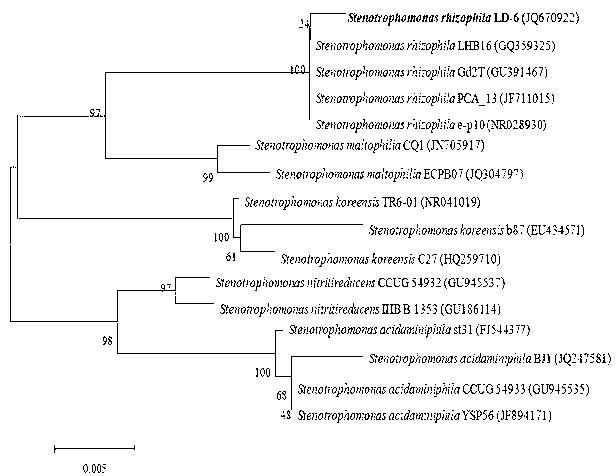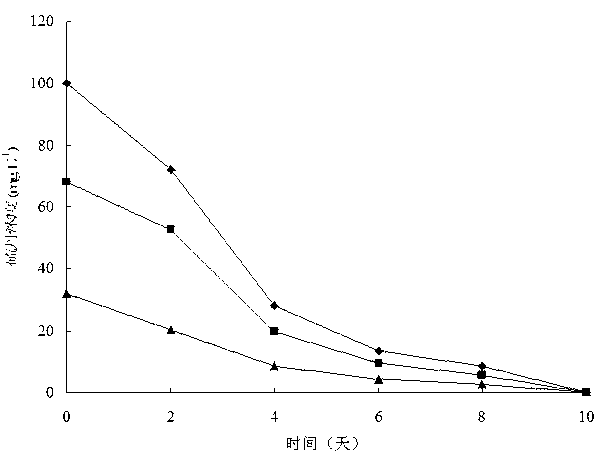Endosulfan degradation stain and application thereof in soil remediation
A technology for degrading bacteria and endosulfan, applied in the field of biological treatment of environmental pollutants, can solve the problems of long residual period, inability to completely degrade endosulfan, high toxicity, etc. The effect of convenient fermentation production
- Summary
- Abstract
- Description
- Claims
- Application Information
AI Technical Summary
Problems solved by technology
Method used
Image
Examples
Embodiment 1
[0029] Example 1: Stenotrophomonas rhizophila Separation of LD-6 and Degradation Ability of Endosulfan
[0030] The sludge near the sewage outlet of Zhejiang Tonglu Pesticide Factory was collected on site, packed in a 150 mL triangular flask, and quickly brought back to the laboratory. The retrieved samples were placed in endosulfan selective basal inorganic salt liquid medium for acclimation culture. The medium composition is (g / L): MgCl 2 0.2, NH 4 NO 3 1, KH 2 PO 4 2,K 2 HPO 4 7.5, NaCl 1, endosulfan 0.1, deionized water 1 L, pH 6.8, sterilized by moist heat at 115°C for 30 minutes before use. The culture conditions are: 28°C, 120 r / min shaking culture, and the liquid volume in the container is 1 / 3 of the container volume. Thereafter, the shaker flask was kept still for a while every 6-7 days, the supernatant was discarded, and then an equal amount of freshly configured selective liquid medium was added to continue the shaking enrichment culture. Four...
Embodiment 2
[0033] Example 2: Stenotrophomonas rhizophila LD-6 drug resistance experiment
[0034] Tetracycline and kanamycin were selected for testing by the filter paper method, and the diameter of the inhibition zone of each antibiotic filter paper (30 μg / piece) on the LD-6 plate cultured with degrading bacteria was used as the criterion for determining sensitivity or resistance . The test results showed that the diameters of the inhibition zones were 24 and 16 mm, showing moderate sensitivity (the range of moderate sensitivity was: tetracycline 23-25 mm; kanamycin 14-22 mm).
[0035] This example shows that when the bacteria are released into the natural environment, super bacteria will not be produced or spread among indigenous bacteria due to drug resistance (resistance), which provides a safety guarantee for its future practical application.
Embodiment 3
[0036] Example 3: Stenotrophomonas rhizophila LD-6 heavy metal minimum inhibitory concentration (MIC) test
[0037] The MIC test design was carried out with reference to the research of Filali et al. (Filali B.K., Taoufik J., Zeroual Y., Dzairi F.Z., Talbi M., Blaghen M. Waste water bacterial isolates resistant to heavy metals and antibiotics. Current Microbiology, 2000, 41( 3): 151-156), pick the same size and activated LD-6 single colony in the culture test tube, shake and culture at 30°C, 160 rpm for 48 hours. The MICs were determined according to the growth of the bacteria, and three replicates were set up in each group to test the tolerance of the bacteria to 13 metal ions. The results are shown in Table 1, the strain has multiple tolerance and strong tolerance.
[0038]
PUM
| Property | Measurement | Unit |
|---|---|---|
| diameter | aaaaa | aaaaa |
Abstract
Description
Claims
Application Information
 Login to View More
Login to View More - R&D Engineer
- R&D Manager
- IP Professional
- Industry Leading Data Capabilities
- Powerful AI technology
- Patent DNA Extraction
Browse by: Latest US Patents, China's latest patents, Technical Efficacy Thesaurus, Application Domain, Technology Topic, Popular Technical Reports.
© 2024 PatSnap. All rights reserved.Legal|Privacy policy|Modern Slavery Act Transparency Statement|Sitemap|About US| Contact US: help@patsnap.com










